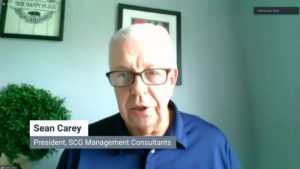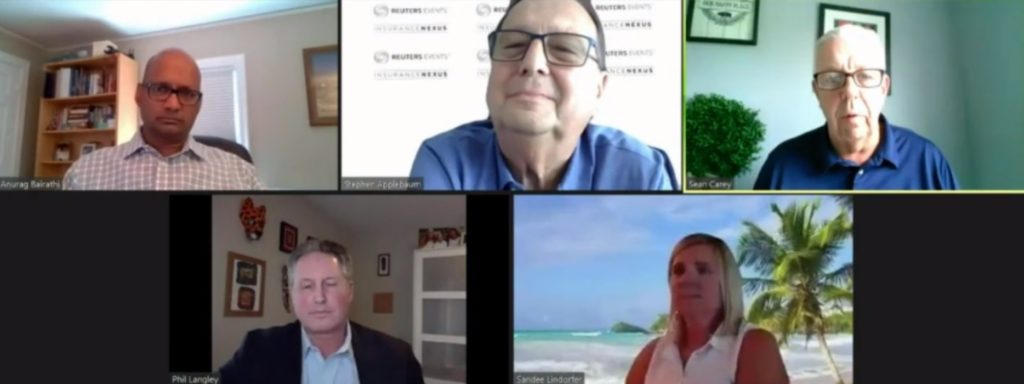
Consultant: Idea of subjectivity in safe and proper repair ‘absolutely nonsense’
By onBusiness Practices | Insurance | Repair Operations | Technology
A automotive claims consultant earlier this summer blasted the suggestion that the definition of a safe and proper repair was subjective.
A written question submitted to a virtual Reuters Events’ Auto Insurance USA 2020 panel on July 29 posed, “Safe/proper repairs can be subjective statement – need to provide safe/proper repairs in a cost effective way to avoid premiums becoming unreasonable. Thoughts?”
Panelist SCG Management Consultants President Sean Carey deflated two key premises behind this statement.
To the idea that a safe and proper repair was a subjective idea, he declared, “No it can’t. That’s absolutely nonsense.” He endorsed OEM procedures as the answer.
He also observed that “we keep down this track” that repair cost increases would lead to higher cycle times and insurance premiums.
“Someone tell me what’s changed so far,” Carey said. Insurance premiums have risen by 58.5 percent over the past 10 years — yet repair costs only have climbed 21 percent, he said.
“That’s not down to the cost of repair,” he said.
The OEMs are open to suggestions on ideas how to do repairs differently, according to Carey. “But in the absence of OEM repair procedures, what are you gonna do?” he said. “You gonna guess how to repair this vehicle?” It can’t be done, he said.
“There’s no subjectivity on safe and proper repair,” he said.
If there is a safe and proper repair, the people that spent six years and $6 billion bringing a vehicle to market “probably have a higher propensity of knowing what that is,” Carey said.
“Let’s start at that point” and figure out how to increase costs and increase efficiency “elsewhere in the whole pipeline of the claim,” he said.
Representatives from Allstate, Liberty Mutual and appraisal firm SCA all expressed support for the idea of OEM procedures.
“Sometimes the OEs don’t always get it right,” said Sandee Lindorfer, Allstate outside auto director for customer experience. She described automakers as “very receptive” when Allstate’s Tech-Cor proposes an alternative procedure, and she encouraged others to contact the automakers.
However, Lindorfer also called it “a positive in many, many ways” that OEMs would be more involved in collision repair. She also cited the past decade’s increase in repair procedures and their accessibility as a positive, and she called Hyundai’s move to share such documents a “huge win” for repairers, insurers and customers, she said.
Lindorfer also called a key component of repair quality ensuring “the repair industry is trained properly so they know what those safe and proper repairs are.”
Liberty Mutual auto field operations, global retail markets and U.S. claims Senior Vice President Anurag Bairathi stressed speed and inexpensive repairs.
However, Bairathi also called safety “paramount.”
“It’s not about repairing the car inexpensively at the expense of safety,” he said. Vehicles are more technology intensive, and it was important to determine the level of repair needed. He called quick and inexpensive pre- and post-repair diagnostic scanning “key to performing that safe and accurate repair quickly.”
He said he completely agreed with Carey’s point. “There is the right way to repair the car,” he said.
Stakeholders working together to clarify and sync up on this “ultimately helps our industry,” he said.
SCA Appraisal Company client services Vice President Phil Langley stressed an “accurate estimate” over speed, noting that SCA’s clients ranked speed “third” as a priority.
A pre-repair day of cycle time ultimately worked out to around $10, according to Langley. But if one were inaccurate by a percentage point on a repair bill averaging $4,000, “that’s $40,” he said. Being off by 2 percent was $80.
Langley said SCA works with Bairathi’s Liberty Mutual to “very, very acutely focus on accuracy, because there’s true dollars there” and policyholder satisfaction if the customer liked the repair process.
Langley said part of an accurate estimate was “taking into consideration all the proper repair procedures.” Later, he described working with SCA clients to produce accurate estimates “consistent with proper repair procedures” and lacking multiple supplements, noting that this probably helped cycle time too.
He extended an “open challenge” to OEMs to help train SCA’s thousands of personnel examining vehicles daily.
We put another OEM procedure question to a July 28 Auto Insurance USA panel examining insurer-automaker collaboration. How would an automaker in such a collaboration address the reality of auto insurers requesting body shops disregard OEM procedures.
“There are no other repair procedures” to address “extremely complex” vehicles, General Motors collision manager John Eck said. No one else creates instructions for GM brands, and failing to use OEM procedures means “you’re gonna do it on your own because that person thinks that they know better. That just doesn’t make sense,” he said.
“No one else” creates instructions for his company’s brands.
The first part of an OEM-insurer collaboration is understanding how to fix the car safely and efficiently, and that would be based upon OEM repair procedures. “That’s the starting point,” he said.
One could “chip away” at the cost of a claim in other areas, but not in using OEM procedures to produce safe and proper repairs, according to Eck. “You can’t separate the two,” he said.
“We follow the repair procedures,” Caliber supply chain strategy and procurement Senior Vice President Dave Smith. He said he felt most repairers would follow the automaker instructions, and he would be “shocked” to hear an insurer directing a body shop otherwise.
No two crashes are the same, and sometimes procedures developed in a “static environment” must be adapted to the real-world circumstances surrounding a vehicle’s condition, according to Smith. But “you start with following the repair procedures” using proper equipment and training so you can “sit assuredly” that the customer will be happy in the vehicle.
More information:
NASTF OEM repair procedures portal
“CLAIMS & SUPPLY CHAINS” panel
Reuters Events Auto Insurance USA 2020, July 29, 2020
“PANEL DISCUSSION- CARRIER-OEM COLLABORATION”
Reuters Events Auto Insurance USA 2020, July 28, 2020
Images:
SCG Management Consultants President Sean Carey speaks July 29, 2020, during Reuters Events’ virtual Auto Insurance USA 2020. (Screenshot from Reuters Events’ virtual Auto Insurance USA 2020.)
Clockwise from top left, Liberty Mutual auto field operations, global retail markets and U.S. claims Senior Vice President Anurag Bairathi; moderator Stephen Applebaum, managing partner of Insurance Solutions Group; SCG Management Consultants President Sean Carey; Sandee Lindorfer, Allstate outside auto director for customer experience; and SCA Appraisal Company client services Vice President Phil Langley participate in Reuters Events’ virtual Auto Insurance USA 2020 on July 29, 2020. (Screenshot from Reuters Events’ virtual Auto Insurance USA 2020.)

